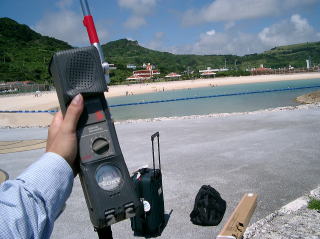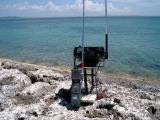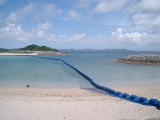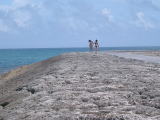They were all coming in! Rather, it should be better said a mixture of
thousands of voices from legal stations to thick voices of illegal ones.
They sounded in the same way as I heard last year. I set up ICB-770 on
a foldable chair and started to be on the air. With my very first voice,
I got a pick-up response from Iwate B73/2, Yokkaichi Port near Nagoya,
and my three-day Okinawa operation was just initiated.
It seemed the channel that I could use was only Ch8 among such a chaotic
conditions. Avoiding the QRM, I was sometimes using Ch6 instead of Ch8
to try to send CQs, but despite the number of legal stations that I could
hear, I was not at all proportionally successful in QSO. Even so, I managed
to succeed in QSO with Ehime CA34/3 and Nagoya CE79. CA34 was operating
in Kyoto, as usual, and CE79 went as far as the south end of Mie prefecture.
I have not scheduled QSOs with these stations known as CB moguls, but it
is a wonder for me that they are always the stations that I could contact
first on these occasions.
After that, although I could make contacts at any time with specific stations in Honshu through Es, no new contact could be successful for some time, due to overlapping, intense signals from outlaws and natural? sort of noises sounding like pi-hyoro-puh. A stronger signal came in from Hyogo AC315 operating at Mt. Rokko, accompanied by a long cycle of QSB. We changed frequencies to Ch3 to try to somehow exchange RS report, however, I could not complete QSO and finally lost his signal, blinded by the illegals.
Around twelve noon, as I announced beforehand in the web bulletin board for CB, I connected an antenna for 6 meters and transmitted CQ from IC-703 on the 6-meter band, intending just for exchange of information with other CB stations. (who had also amateur license) I got immediate responses from Iwate B73/2 and also from Aichi JH316. According to JH316, he went for operation to the mountainside this time to better catch Es DX signals. I returned to IC-770, expecting a QSO with JH316 also on the CB frequency.
It seemed the “clouds” of Es were moving to the East, and signals from
1 Area stations were coming relatively stronger. A station of Tokyo AB505/1,
Saitama Prefecture, was coming in with S5 signal, stable but sometimes
chopped by the outlaw signals. The call sign sounded familiar to me, because
in early June I had just made an Es contact with him from Hyogo Pref.,
and when I returned to Tokyo I had several times of QSO with him last year.
This time again, I was successful in making QSO, by changing frequencies
and managing communications during the very brief continual weakness of
illegal overlaps. I also succeeded in QSO with Ehime BX58, Matsuyama, catching
the instance of his signal rising up from the background.
As scheduled, I was on the air from 14:00 at 50.720MHz, but there was no station picking me up. I tuned to the lower frequencies of 6 meters and saw it was still bustling there with many stations under good propagation. Since I noted a scheduled operation also on 15 meters in the web BB, I set up an antenna for 15 meters, and started operation at 21.160MHz…just for liaison purpose. I had been worried about it but I was picked up at once. Calls for me continued for some time. It was partially as I expected but partially somewhat disappointing that the amateur stations that I contacted were not either CBers operating on the day. Eventually, though it was lucky I could somehow sentence a QRT, I lost about 40 minutes for supposed-to-be a mere liaison communication. Then I thought I should not make any call on 15 meters during the rest of the travel this time.
The QSOs with 7 and 8 Areas on 15 meters had a weak QSB. I perceived the propagation by F Layer would be going down, but stations of 11 meters through Es were still good to hear. Even so, after 15:00 the condition appeared gradually going down, and less and less stations and noises were coming.
I was scheduled to come back to Naha Airport in the evening to fly to Ishigaki
Island. Putting aside the 87R only, I finished re-packing of the equipments
around 16:00. View of the beach was still coming in to me, who drank up
a bottle of tea which had long before changed to hot one. The condition
of sky in light of propagation did not seem any better, but just in case
I was trying out CQs. Shizuoka DD23 could respond to me. Such words as
‘from the middle point of Mt. Fuji’ were fresh and impressive. Following
that station, I was also picked up by Fukuoka NS45 for QSO. Finally, I
completed packing 87R and got into taxi for Naha Airport.
Rigs: ICB-770、ICB-87R、ICB-707、IC-703 (amateur radio)
Power: Lithium-ion batteries 19Ah (6.6Ah: 1、3.2Ah: 2、3Ah: 2)
Antennas: For 6 meters: 1/2 wave length, voltage driven (rod type)
For 15 meters: 1/2 wave length, voltage driven (wire + LC matching section) (self-made)
Others: antenna tuner (for QRV on 20 meters), antenna analyzer (RF-1, for checking impedance), coaxial cable 3m, fishing rod 5.4m, tripod stand, 2 foldable chairs, battery charger, etc.)
It was a loss for me to carry those kinds of staff for amateur radio (batteries,
antennas, etc.), because I did operate the amateur only for a short time.
From the beginning, because it was supposed to be just for a liaison purpose,
it should be rather said it was expected.)
|
 |
2007 OKINAWA






